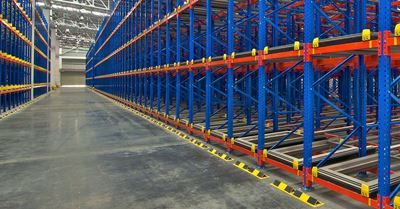Push Back Rack | Long Beach

Raymond West offers pushback rack in a variety of styles and capacities.
We are one of the largest industrial racking suppliers in the state.
Call us today at (562) 444-1222
What Is Push Back Racking?
Push back racking (also known as pushback rack) is an extremely efficient pallet storage approach that allows pallets to be stored from 2 to 6 units deep. Pallets rest on linked shuttles that are pushed up a gradual slope as products are loaded, or “pushed back” from the face of the racking system.
When pallets are later pulled, the pallet abutting the front pallet glides back down the incline to the facing slot.
Push Back Rack Advantages And Disadvantages
Pushback rack is excellent for some operations, but isn’t suitable for every warehouse. There are several benefits and drawbacks to take into consideration.
Higher Density Storage
Since push back pallet racks can store between 2-6 pallets in any particular position, they can eliminate somewhere from 1-5 aisles, which represents a significant amount of warehouse space.
Less Forklift Travel
By eliminating aisles, forklifts don’t have to make as many trips, reducing equipment wear and increasing efficiency. Diminished forklift movement also improves safety by a significant factor inside the warehouse. Less travel means fewer safety infractions.
Greater Selectivity
Pushback rack offers a nearly perfect mixture of selectivity and storage efficiency. In contrast to drive-in rack, where entire storage bays are generally a single SKU, pushback rack provides instant access to many more pallet positions from the face.
LIFO Configuration
Dissimilar to pallet flow rack, which is a First In First Out (FIFO) style of system, push back rack is a Last In First Out (LIFO) style of storage. LIFO systems are not a good option for goods that are perishable, because goods that are stored early may sit for long stretches of time as goods are loaded and removed at the front of the lane.
How Does Push Back Racking Work?
Push back rack configurations include a couple of tracks declining in the direction of the rack face and a collection of nested shuttles which travel on these rails.
An initial pallet is added on the highest cart by a forklift. When another pallet is positioned, the lift truck operator pushes the primary pallet back and places the next pallet on the second cart. The final pallet placed in the lane is seated on the tracks.
As goods are retrieved, carts of unit loads slide down the rails. Lift truck drivers remove each pallet in turn until the lane is empty, or introduce new pallets, filling the lane back up.
Push Back Pallet Racking For Sale
To learn more about push back racking systems, call a racking professional at Raymond West today. Raymond’s warehouse design engineers can help you develop a system that is ideal for your application.
Raymond West's Long Beach service area includes Long Beach, North Long Beach, Wilmington, San Pedro, Lomita, Torrance and nearby surrounding areas.
Raymond West | Long Beach Material Handling Equipment Supplier
Long Beach
(562) 444-1222

